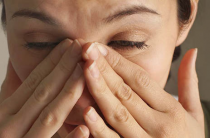Despite the fact that adults experience signs of allergies less often than children, this disease among the adult population is also very widespread. What are the allergic manifestations that adults face? This is primarily a diverse nature of skin rashes, respiratory disorders, gastrointestinal problems, inflammation of the eyes, as well as other disorders that are companions of allergic disorders.
Symptoms of an allergic reaction occur with varying degrees of severity. With a mild allergy in an adult, tearing of the eyes, a runny nose and sneezing may appear. But also, some patients experience severe allergic manifestations that cause dysfunction of the respiratory system and can cause death. A wide variety of substances that constantly surround a person can become a causative factor in allergies. It can be food, plant pollen, dust that accumulates in houses, etc. The patient's immunity reacts extremely sharply to their intake, which is the reason why the signs of the disease appear.
Allergy and respiratory symptoms
Respiratory disorders in adults are common signs of allergies. An excessively dry or cold climate, tobacco smoking, dustiness, and unfavorable environmental conditions have a negative impact on respiratory (developing in the respiratory system) allergic reactions. However, the leading role in the appearance and development of symptoms of the disease remains with allergens.
The signs of this group consist of various manifestations of allergy in adults, which include the organs of the respiratory system. Individual organs (nose, bronchi, trachea, etc.) or the entire respiratory system may be involved in pathological reactions.
Allergic swelling of the oropharynx is accompanied by irritation, which is localized in the throat area and is manifested by a feeling of perspiration. An acute cough can also be observed, which, due to the fact that it often occurs dry, gives discomfort to an allergy sufferer. With an allergic cough, redness on the face is noticeable, which indicates an allergic expansion of the capillaries.
Allergy symptoms involving the respiratory organs are directly dependent on contact with allergens and occur almost instantly. If they are present as part of an allergy to dust or pollen, then their appearance can be noticed after exposure to allergens along with the inhaled air. In the case of an allergy to animal hair, the cause of their development is close contact with a pet or its waste products.
allergic rhinitis
The nose is one of those organs that suffers from respiratory allergies in adults more often than others. This is due to its leading role in the implementation of respiratory processes and, as a result, the most frequent contact with allergens. A group of symptoms characterized by inflammation of the nasal passages is united under the general name "allergic rhinitis". First of all, during allergic rhinitis, the nasal passages swell very much, due to the expansion of local vessels and the accumulation of fluid. As a result, the inhalation of air through the nose is fraught with great difficulties. The patient either breathes heavily through his nose, or is completely forced to breathe only through his mouth, if the signs of swelling are extremely acute.
Edema processes, which are localized in the nasal mucosa, pass along with watery secretions that occur with high intensity. In addition, sneezing is observed. On this basis, you can immediately recognize the presence of a respiratory allergy, since the patient begins to sneeze a few seconds after inhaling the allergen.
Skin signs of allergy
Skin signs of allergy in adults are external manifestations of the body's sensitivity to an allergen that has entered the body or had an effect on any area of the skin. Many cases of allergies that acquire a skin character are due to the body's sensitivity to the active ingredients of medicines and food, as well as to cosmetic and hygiene products. Adults are also at risk for skin allergies if their work is related to the chemical industry or other potentially harmful production.
Skin allergy symptoms:
- Areas of the skin are very itchy;
- The appearance of rashes, which can have a different shape and size;
- Redness due to edematous manifestations;
- The upper layers of the skin dry out and peel off;
- Inflammatory processes;
- Isolation of weeping substances in places of an allergic rash;
- The appearance of blisters, vesicles, blackheads and other formations;
- There is traumatization of the skin of various depths;
- After the skin signs of an allergic reaction have gone, scars, scars and furrows may remain in their place.
There are a large number of varieties of allergic rash in adults:
| Name | signs |
| nodular rash | It is characterized by the appearance of skin formations in the form of a frequent accumulation of small dots, the contents of which are transparent or dark wet discharge. |
| nodular rash | Unlike nodular, the size of the rash is larger, but less frequent. |
| Redness | Areas of the skin in the places of localization turn red, which is associated with the expansion of adjacent vessels. They can occur with or without swelling. |
| Spots | Changing the color of the skin, or their pallor. The relief of the skin does not change. |
| Acne | The accumulation of elements, which is an inflammation of the skin pores, inside which there is a slight suppuration. |
| blistering rash | The appearance of various diameters and sizes of bubbles with a clear liquid. In appearance, it is very similar to a burn. |
Allergy symptoms and eyes
The anatomical structure of the eye, which has a permeable mucous membrane, often comes under the influence of allergens. This occurs when the patient is sensitive to substances in the air (dust, pollen, fungal spores, etc.). This leads to the fact that in addition to the respiratory organs, during respiratory allergies, there are also signs of inflammatory activity occurring in the eye area and adjacent skin areas. Signs of allergy in the eyes can manifest themselves with intensity of varying degrees; in addition to the individual characteristics of the clinical picture, the amount of the hazardous substance and the time during which the interaction with it took place are important.
Signs of an allergy in the eyes:
- intense itching in the eyelids, their swelling is noted;
- there is dryness and tension of the skin of the eyelids;
- dryness and peeling are noted in the corners of the eyes;
- redness of the eyes, caused by the fact that local vessels expand under the influence of allergens;
- eyes quickly get tired, irritated and react sharply to bright lighting;
- eyes watery often and with the release of a large amount of fluid;
- the eye membrane turns red;
- the patient often rubs the eyes because they are irritated and there is severe itching;
- visual acuity decreases (a reversible phenomenon).
Allergy symptoms affecting our eyes in adults mainly occur if the allergen has had a direct effect on the mucous membrane or surrounding areas. They are often combined with signs of inflammation of the respiratory system, combining into one set of symptoms.
Gastrointestinal signs of allergy
Allergy symptoms that affect the digestive system may be present as part of a food allergy, combined with skin symptoms. Their mutual development side by side with respiratory symptoms or eye lesions is found much less frequently. Exposure to allergens may be too strong for the walls of the stomach or intestines. In this regard, there may be observed: the presence of heaviness in the lower abdomen, which is accompanied by pain, as well as frequent belching, a feeling of nausea. With a particularly severe clinical picture, the patient can vomit after a certain time after the intake of the allergen. All this is extremely similar to the signs of gastritis, so a specially directed delimiting diagnosis is required between these diseases.
Provided that the mucous tissues of the gastrointestinal tract are sensitive to allergenic effects, after 2-3 hours the patient experiences intestinal colic, later diarrhea may also occur, or vice versa, manifestations of constipation. The patient's stool is characterized by the presence of fatty drops or fragments of food in an unchanged form. The gastrointestinal tract in allergic disorders is not able to fully cope with its biological function - the full absorption of nutrients. Therefore, under the influence of food allergies, adults begin to lose weight, feel weak, have a pale complexion, and signs of a deficiency of vitamins and minerals.
Bronchial asthma is a sign of allergy
Bronchial asthma is another manifestation of an allergic reaction that adults have to deal with. This is due to the fact that in addition to one's own predisposition, in its occurrence a significant role is played by ignoring the initial respiratory symptoms, which is often allowed by people of the older age group.
Bronchial asthma is a disorder of the respiratory system, which has a very unfavorable course for the patient. The main reason why bronchial asthma occurs is the failure of the bronchial system, under the influence of allergens. After penetration has been made, the body immediately begins to synthesize antibodies that affect the respiratory system. This process takes just a couple of minutes. Symptoms of bronchial asthma can appear after contact with substances such as: plant pollen, animal hair, fish food, house dust, particles of washing powder, etc.
Symptoms of bronchial asthma in adults:
- hard breath;
- breathing accompanied by extraneous sounds;
- chest pain, feeling of pressure;
- dry cough, at the end of which there may be accumulation of fluid;
- suffocation;
- inhalation and exhalation is performed with the participation of skeletal muscles.
The symptoms of bronchial asthma with allergies are provoked by the fact that the allergen entering the patient's body initiates a cascade of reactions that lead to a sharp compression of the bronchial muscles. This leads to a narrowing of the respiratory gap and causes suffocation.
Quincke's edema
Quincke's edema is an acutely intense course of an allergic reaction that occurs as a result of the fact that the lower layers of the skin and mucous membrane undergo acute edema. The influence of allergens in this situation leads to the fact that the vessels in tissues of this type expand intensively and release a large amount of liquid content into the tissue cavity. Adults often experience this phenomenon with allergies to poisonous insect bites, food allergies (seafood, chocolate, vinegar) and sensitivity to drug components.
A characteristic sign of Quincke's edema is intense swelling that occurs on the tissues of the face, limbs, neck and upper chest. If swelling occurs in the larynx, the patient begins to feel suffocation. This is a variant of the development of this disorder, representing a mortal danger. Intense edema disrupts blood circulation, as a result of which the patient has a lightning-fast decrease in blood pressure, which can also cause cardiac arrest. If you notice signs of edema that develops very quickly, or it happens before your eyes, call the medical team without delay. Before she arrives, provide the unfortunate person with maximum access to oxygen by opening all the windows and doors in the room and freeing him from clothing that tightens his throat.
Anaphylactic shock
Anaphylactic shock is another dangerous variant of the development of allergic manifestations. Unfortunately, his danger is such that in some cases, even an experienced first aid team may not save his victim.
Signs:
- extensive itching, accompanied by the appearance of a rapidly spreading urticaria;
- a sharp increase in body temperature (the patient feels a surge of heat);
- pain in the abdomen or heart;
- lowering blood pressure;
- the appearance of anxiety, increased heart rate;
- larynx and bronchi seizes a spasm.
Spasmodic contractions of the muscles of the larynx and bronchi lead to respiratory failure. As a result, the patient may die from asphyxia. A greater risk is also represented by cardiac arrest, which can occur during the development of anaphylaxis. The scheme of actions is similar to that for Quincke's edema - call the medical team as soon as possible and provide maximum oxygen access.
Signs of different types of allergies
Allergy to gluten
One of the most common instigators of allergies in adults is gluten, which enters the body when eating oats, wheat, barley and rye. Some people, due to the characteristics of the gastrointestinal tract, cannot completely, and sometimes even partially process this protein. As a result of this, irritation of the gastrointestinal system occurs, and subsequently the stimulation of the immune response when it enters the bloodstream.
With an allergy to gluten , a rash on the skin, abdominal pain, stool disorders, and sudden weight loss (without dietary restrictions) are observed. Gluten can also affect the brain, causing migraine attacks, as well as worsen general well-being, causing weakness and joint pain, reminiscent of symptoms of SARS. If you are allergic to gluten, it is strictly forbidden to eat cereals, in which it is present, as well as their products. It should also be taken into account that it is widely used in the food industry, where it is used to give a thick consistency to some products. There is only one way out - to carefully monitor the composition of the finished product (semi-finished products, sauces, sausages, etc.).
Allergy to citrus
Sensitivity to the components of citrus fruits is a very common occurrence in our latitudes. They are in the equivalent ratio of both children and adults. Gender doesn't matter either. It has been observed that the colder the climate, the more common citrus intolerance. This is due to the fact that the immunity of a person living in a cold climate is not genetically familiar with the components of these products and often perceives them with hostility.
In addition to being powerful allergens, citrus fruits also contain histamine, which is no different from our natural hormone. It is this biological compound that provokes allergy symptoms. Therefore, even an adult, with the absence of allergic sensitization, can observe signs of allergy in himself.
Signs of allergy in adults after eating citrus fruits: rash, discoloration of the skin, intense itching, gastrointestinal disorders, watery eyes, redness, sore throat.
Allergy to seafood
Seafood is a powerful and insidious allergen. Firstly, this is due to the fact that seafood (crustaceans, fish, mollusks, etc.) contains a lot of protein, even in relation to such products as meat and eggs. For 100 grams of marine products, the protein share is more than 20 percent. Secondly, the structural feature of the protein components that make up their composition is such that they retain their primary appearance under the influence of the temperatures used for cooking.
Allergy to seafood is manifested by disorders of the digestive system, skin itching, as well as disorders of the respiratory system, which is often involved in the process of allergic reactions to seafood.
Signs of allergies in adults, the manifestation of which is associated with seafood. a few hours after they enter the gastrointestinal tract, their manifestations become obvious. They include: redness and swelling of the epidermis, swelling of the tongue, larynx and tongue, sore throat, dry cough, bloating and pain in the abdomen. Allergies to shrimp, oysters and mussels are of great danger. It is these types of food allergies that most often become the trigger for anaphylactic shock.
Allergy to animal fur
Symptoms of an allergy to animal hair can be encountered even if it does not fall on the patient. The fact is that allergens are metabolic products that are produced by the glands of the animal and deposited on the coat. In addition, they can also be on the floor, on pieces of furniture and right in the air. The sensitivity of the immune system of some people is so aggravated that even an insignificant amount of the allergen that hovers in the air of the room is already enough to cause allergy symptoms.
First of all, after bodily contact with the traces of his stay, redness, tearfulness of the eyes, as well as sneezing are noted. Then it lays very strongly and there are sensations of discomfort in the throat area. In the very first minutes, after the patient has inhaled the allergen, these signs will be manifested.
Allergy to dust and pollen
Plant pollen and house dust also provoke allergic reactions in adults. Unlike food allergies, when it is enough to simply refrain from eating a harmful product, in this case it is much more difficult to protect yourself from it. These allergens are widespread and completely protected from them, alas, does not work.
Upon contact, respiratory signs are present: symptoms of allergic bronchial asthma, rhinitis and conjunctivitis. The patient usually knows that these allergens are the culprits of the disease, because the symptoms occur almost instantly.
Allergy to insect stings
This form of allergy in adults is extremely dangerous. The fact is that after the penetration of the allergen in many allergy sufferers, the development of the reaction becomes extremely acute. There is a high probability of developing symptoms of anaphylactic shock and/or Quincke's edema. Insects that belong to the Hymenoptera order (hornets, wasps, bees, bumblebees) provoke acute forms of allergies. These insects have a colossal distribution in our latitudes, therefore, allergy sufferers should have specialized means for relieving acute allergic symptoms, as well as be able to put them into practice. You should obtain this information from your doctor.










